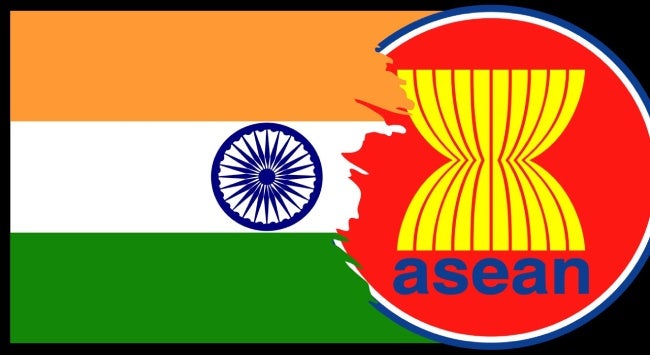Summary
The India-Association of Southeast Asian Nations (ASEAN) Free Trade Agreement has, so far, been a largely unappealing framework for both sides. However, it can be made more effective, as it should, given the new trade challenges facing India and the ASEAN member states.
Regional relationships, especially those with wide breadth and variety, such as between India and the Association of Southeast Asian Nations (ASEAN), are difficult to be described in simplistic terms like ‘good’ or ‘average’. These relations evolve with time and circumstances. New circumstances can make earlier achievements in the relations look irrelevant. The India-ASEAN Free Trade Agreement (FTA) is a classic case in point in the context of India’s relations with Southeast Asia.
The India-ASEAN FTA on goods came into force from 1 January 2010. The agreement on services and investment followed in November 2014. Taken together, the two agreements comprise one of the five ASEAN+1 FTAs. Among the latter, the agreement with Australia and New Zealand was the most comprehensive in depth and coverage of market access commitments for goods, services and investments. The India-ASEAN FTA was the lowest in ambition and scope. This itself made the FTA a non-starter as traders on both sides found little value in using it due to its limited appeal. The appeal remained stunted due to the greater scope of India’s bilateral FTAs with major ASEAN member economies – Singapore and Malaysia.
From the Indian exporter’s perspective, the India-ASEAN FTA presented high user costs. This is a generic limitation of many of India’s old-generation FTAs. Exporters avoided using the FTA due to complicated rules of origin and laborious documentation, which meant high opportunity costs for claiming preferential market access benefits.
Low utilisation rates also meant most regional trade between India and Southeast Asia was taking place outside the framework of the bilateral FTA, making the latter a largely irrelevant framework. However, this also meant that the high trade deficit between India and ASEAN, which has significantly increased since the implementation of the goods FTA in 2010, cannot be attributed to the FTA.
The disappointment and frustration in both India and Southeast Asia over an FTA limited in scope and difficult to use is natural. While its introduction was greeted with enthusiasm, marking an important milestone in India’s ‘Look East’ policy and engagement with Southeast Asia, its structural weaknesses has made it economically dispensable.
With more and more new FTAs producing greater depth and coverage, the India-ASEAN FTA not only looks limited in scope, but also lacks new generation trade issues, such as digital trade and the environment. With both India and several ASEAN member states engaging in modern and comprehensive FTAs with the European Union, the United States(US) and other major global economies, the India-ASEAN FTA has shrunk further in strategic interest.
It is hardly surprising, therefore, that neither ASEAN nor India have shown active interest in revitalising the FTA. The bilateral review initiated for this purpose is hardly moving. Matters have not been helped by increasing strategic divergence between India and ASEAN, leading to mounting trust deficit, further impacting the outlook towards the FTA.
However, a turnaround might be in sight for the much-maligned FTA. This is indicated by the comments of the Indian Commerce Minister Piyush Goyal, following his meeting with his Malaysian counterpart, Tzafrul Aziz, and the intention to ‘fast-track’ the review.
The following months will indicate whether the FTA gets a fresh lease of life. Many factors, especially the current US trade policy, support a new look, as does the comprehensive strategic depth that India-ASEAN relations have acquired over time.
With more and more new tariffs being announced by the US on trade partners in Asia and various bilateral deals being struck, the preferential market access landscape has become heavily fragmented. With such access to the US’ market becoming tightly contested among Asian economies, diversifying trade from the former is no longer wishful thinking.
Both India and Southeast Asia are aware of the long-term importance of diversifying exports from the US’ market. Their respective markets can be a good alternative in this regard. A revamped and modern bilateral FTA can be an important tool for achieving the objective.
Recharging the India-ASEAN FTA might not be as onerous as it appears. Correcting the basic flaws, such as simplifying the complex rules of origin, can send a positive signal to exporters and generate business confidence in the agreement. Furthermore, extending tariff cuts already offered by India and ASEAN to their other FTA partners, to the bilateral FTA, will immediately improve market access prospects, as will the addition of new provisions such as digital trade, clean technology and financial services, which will encourage new-generation businesses from both sides to engage with the FTA.
India and ASEAN in 2025 are much different from what they were in 2010. An FTA reflecting the new times, interests and conditions can have high take-up appeal.
. . . . .
Dr Amitendu Palit is a Senior Research Fellow and Research Lead (Trade and Economics) at the Institute of South Asian Studies (ISAS), an autonomous research institute at the National University of Singapore (NUS). He can be contacted at isasap@nus.edu.sg. The author bears full responsibility for the facts cited and opinions expressed in this paper.
Pic Credit – ISAS=NUS and Wikimedia Commons
-
 More From :
More From :
-
 Tags :
Tags :
-
 Download PDF
Download PDF



